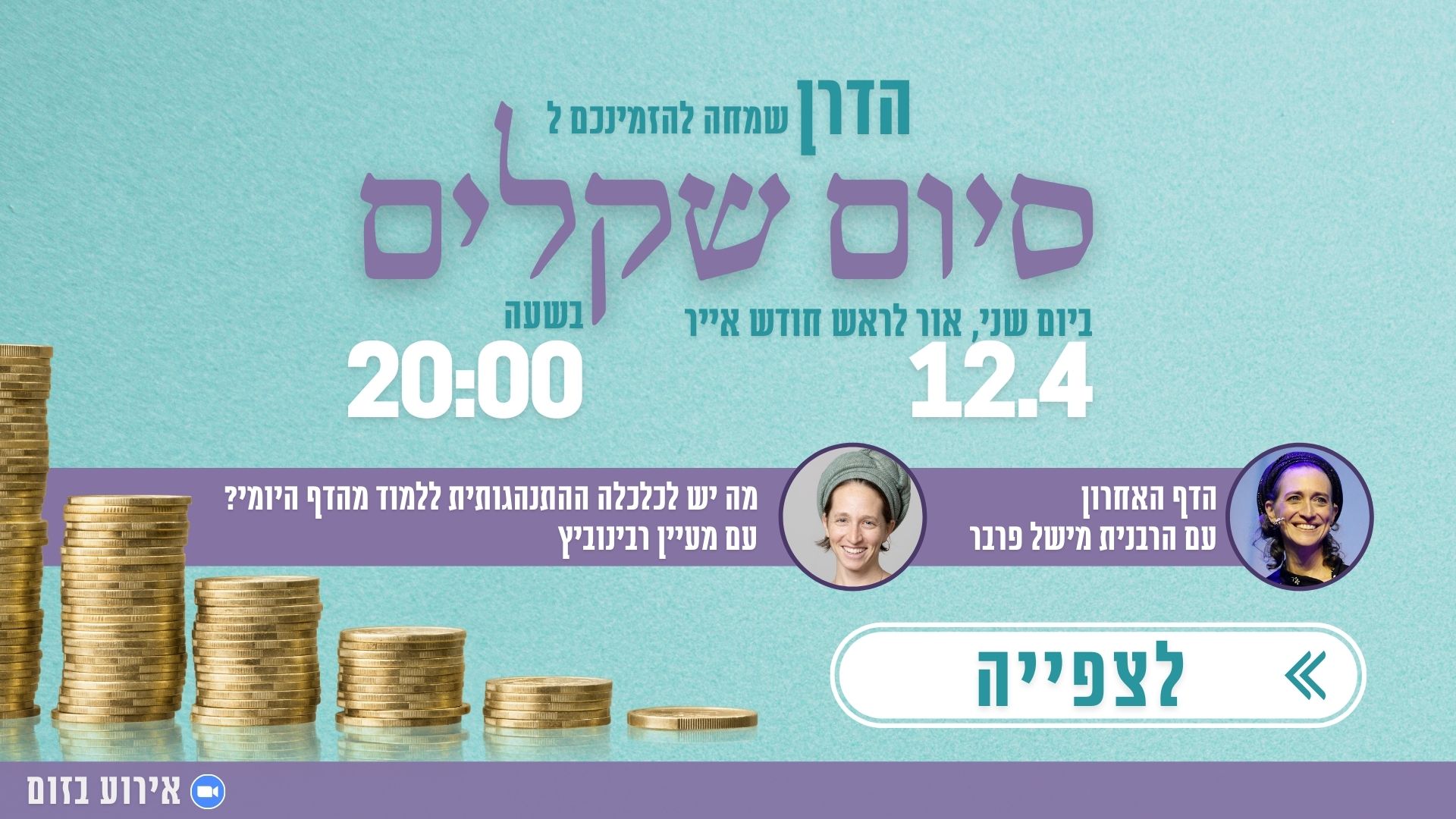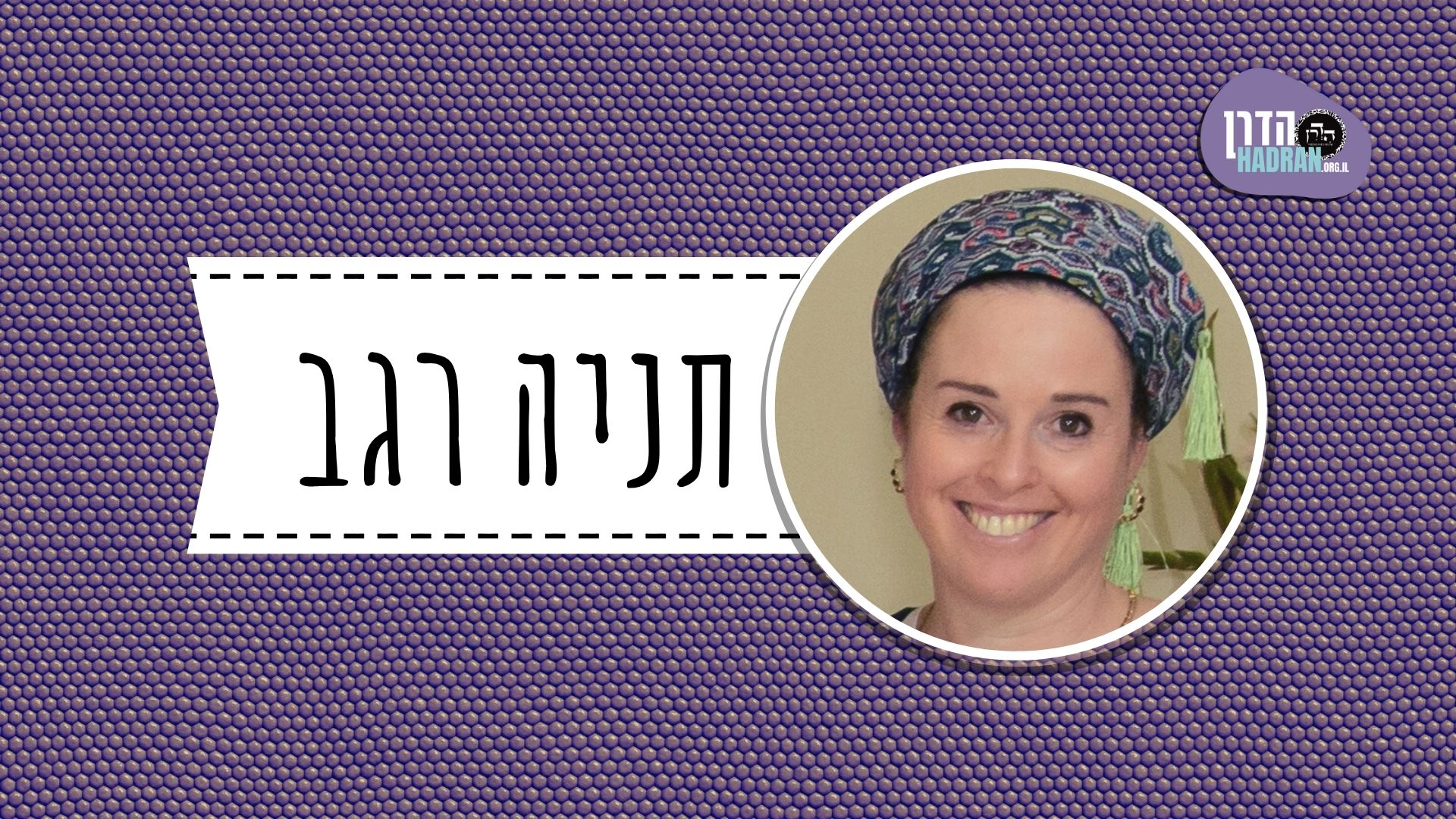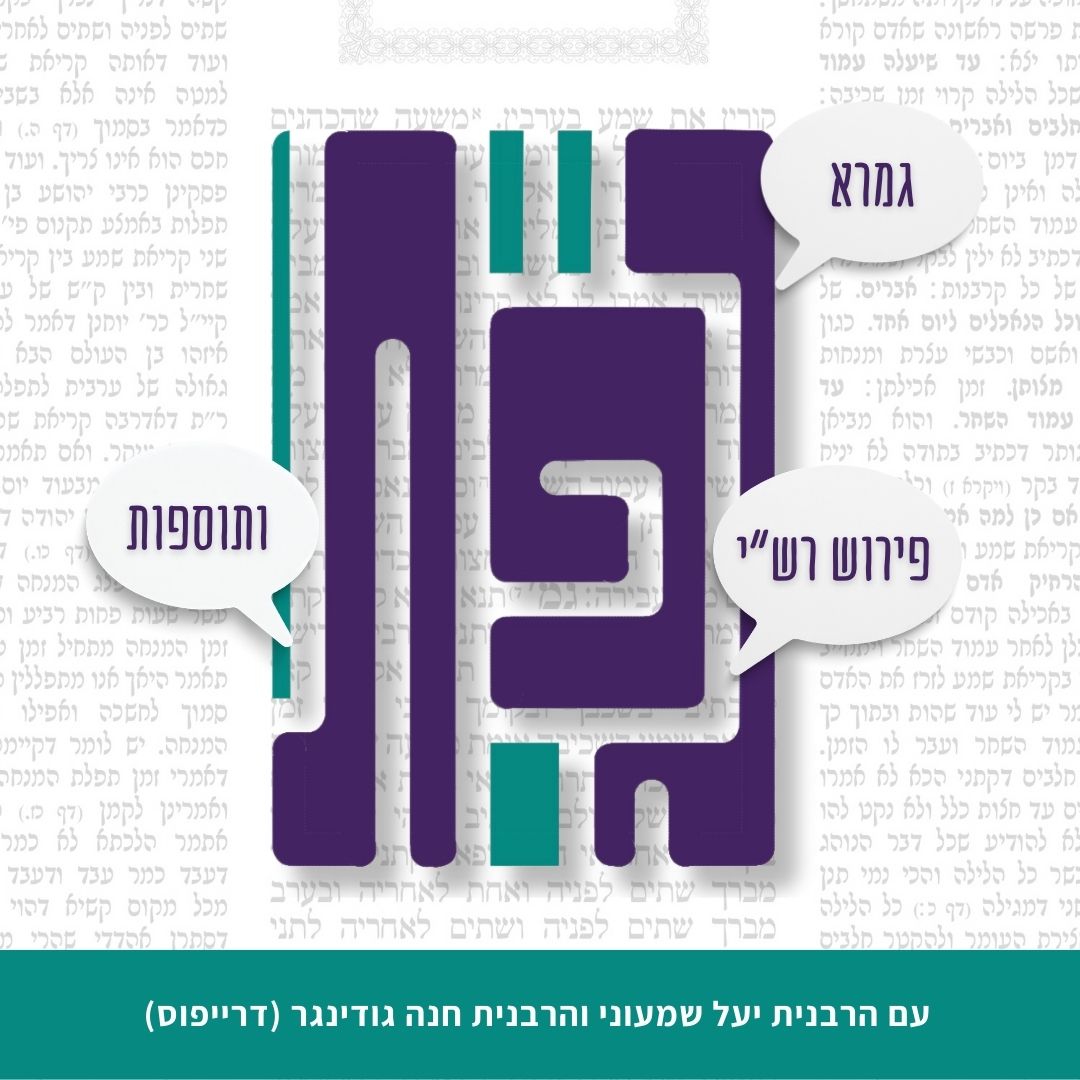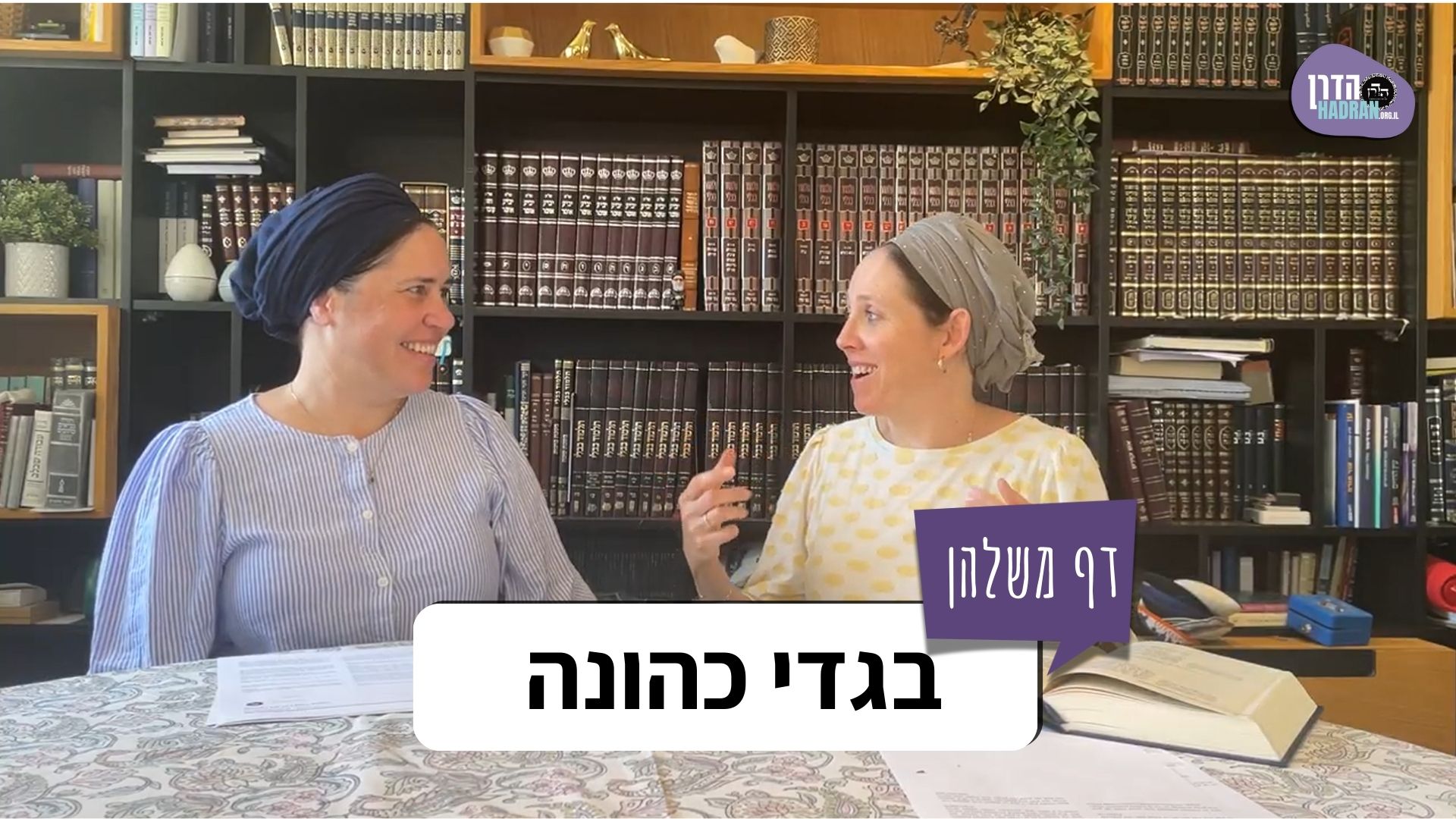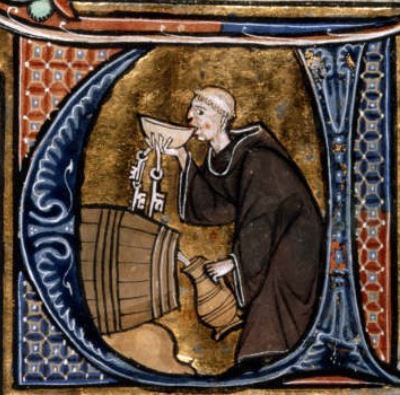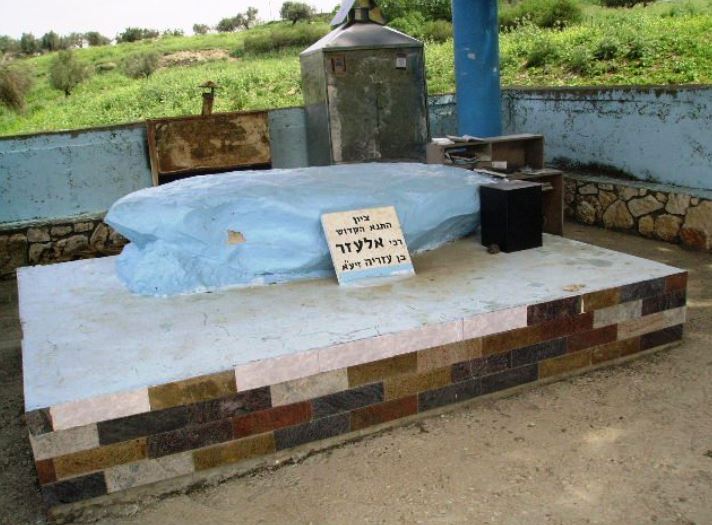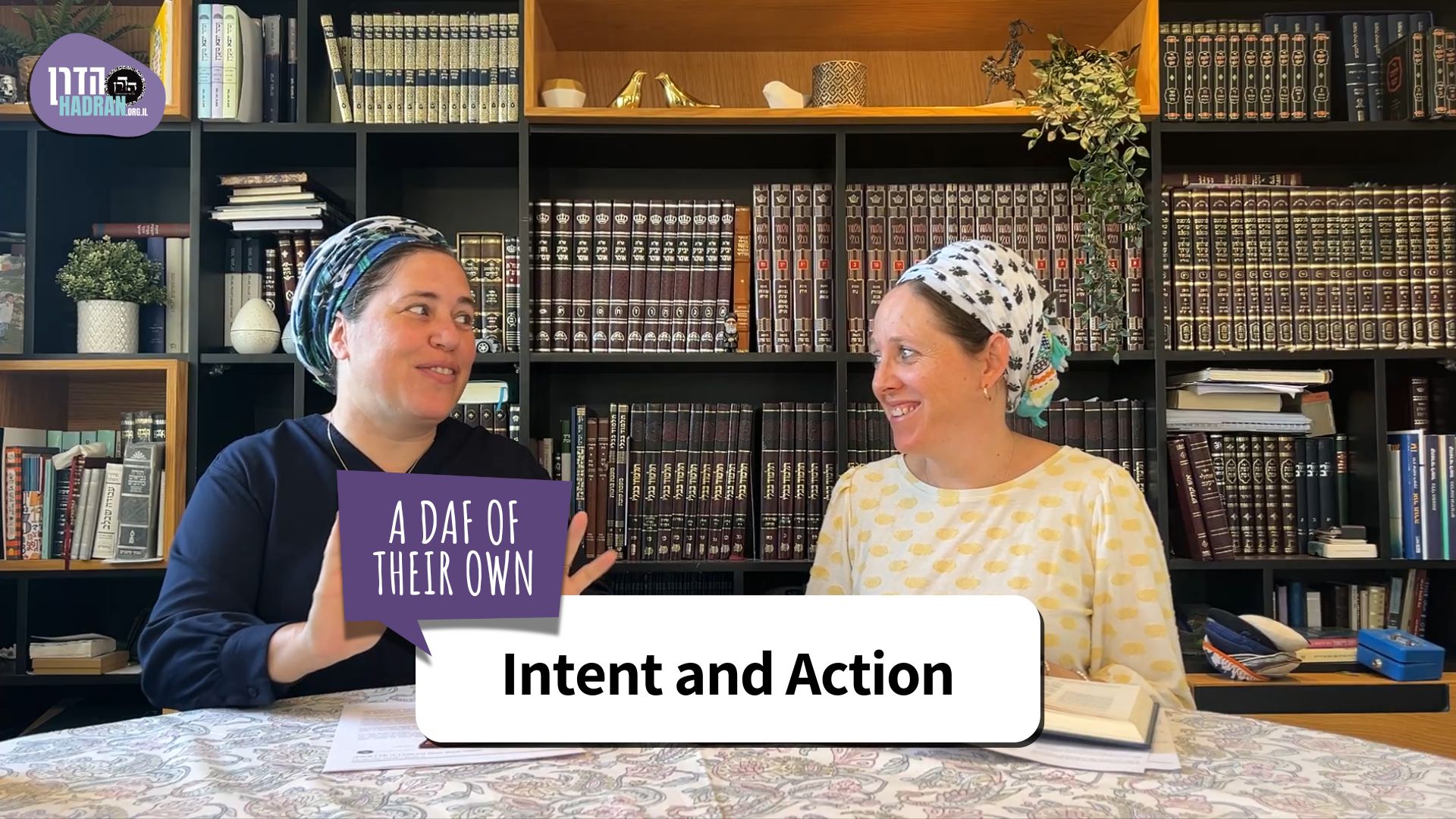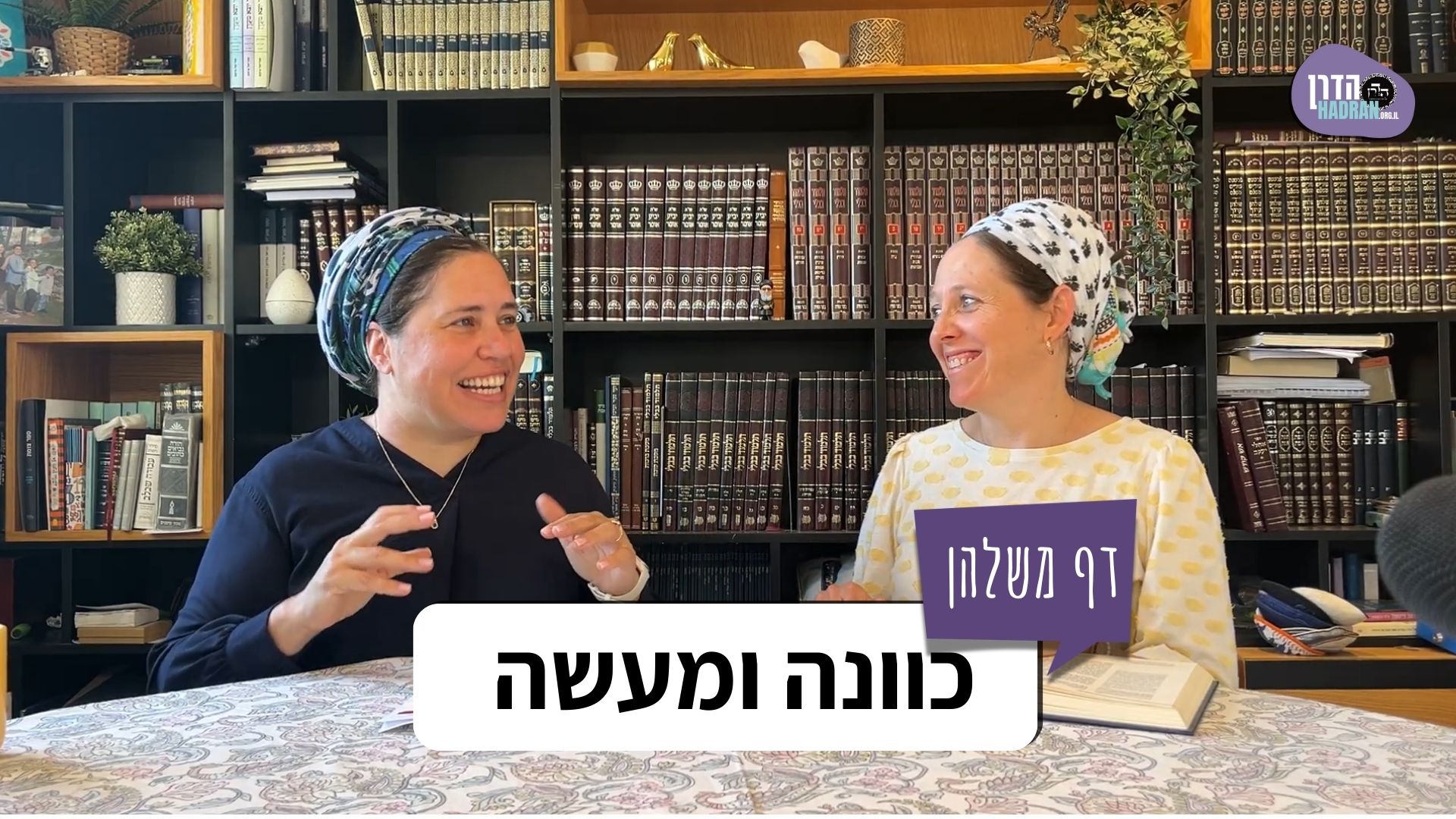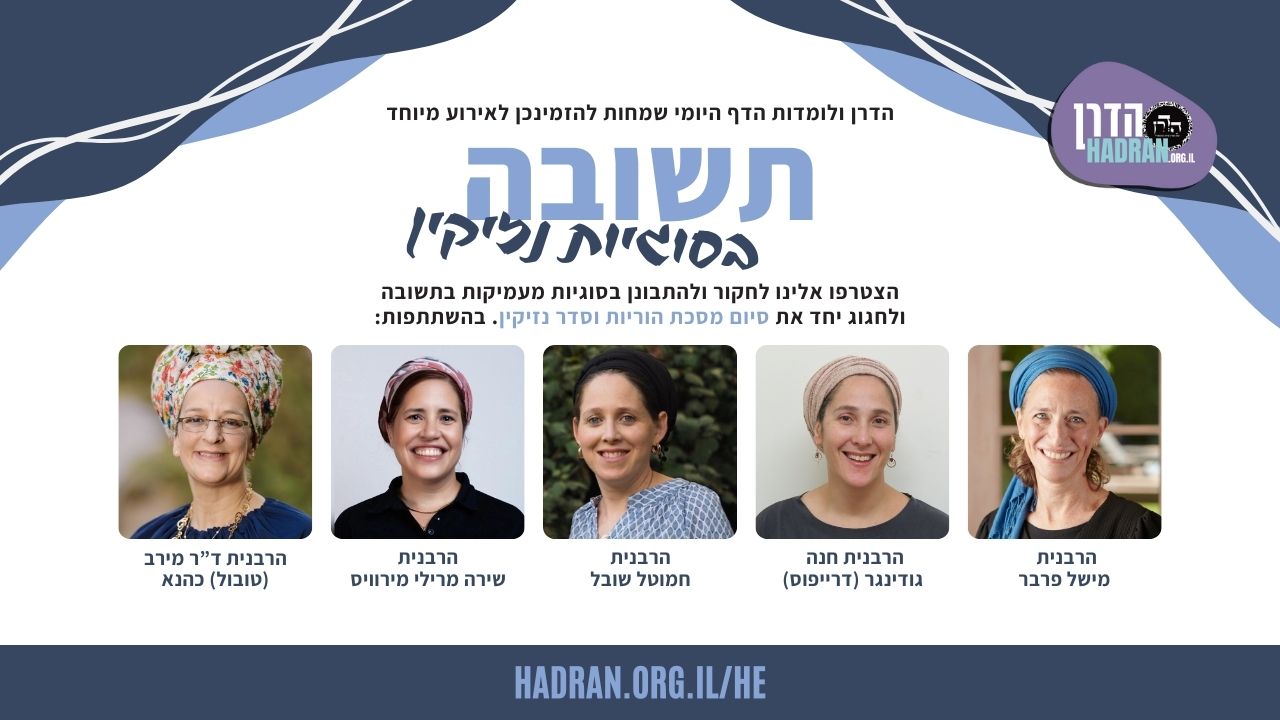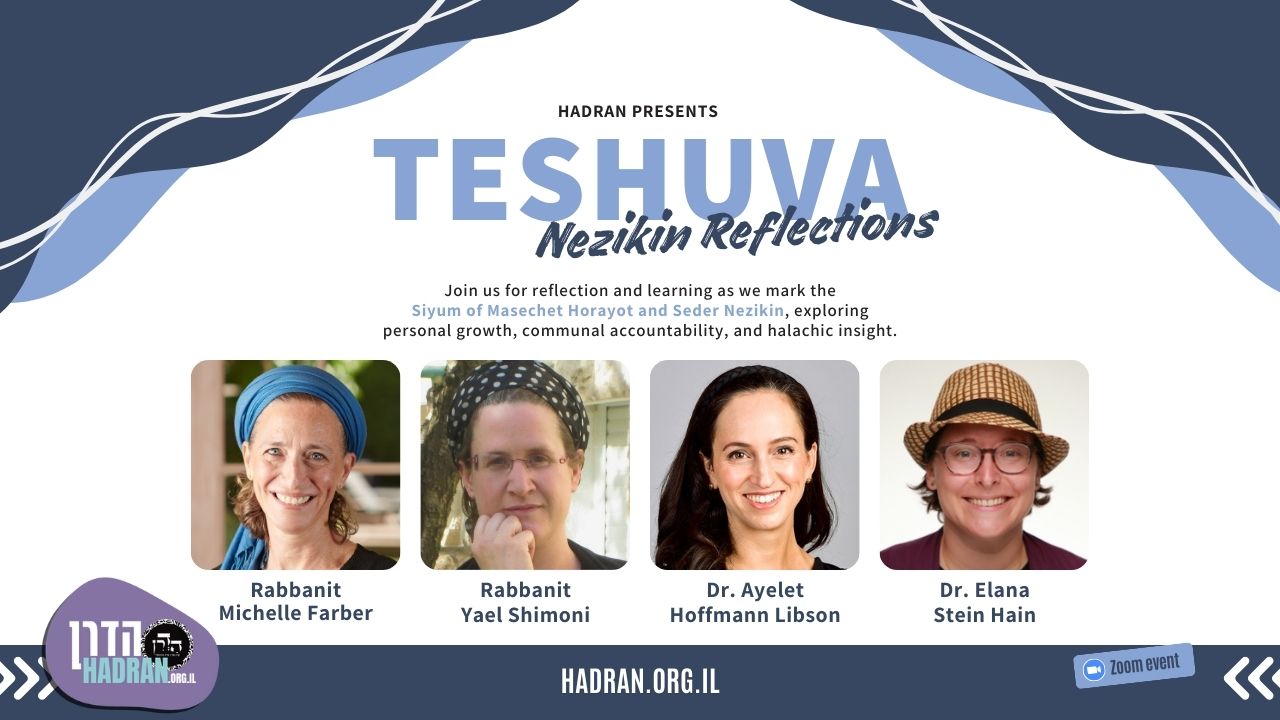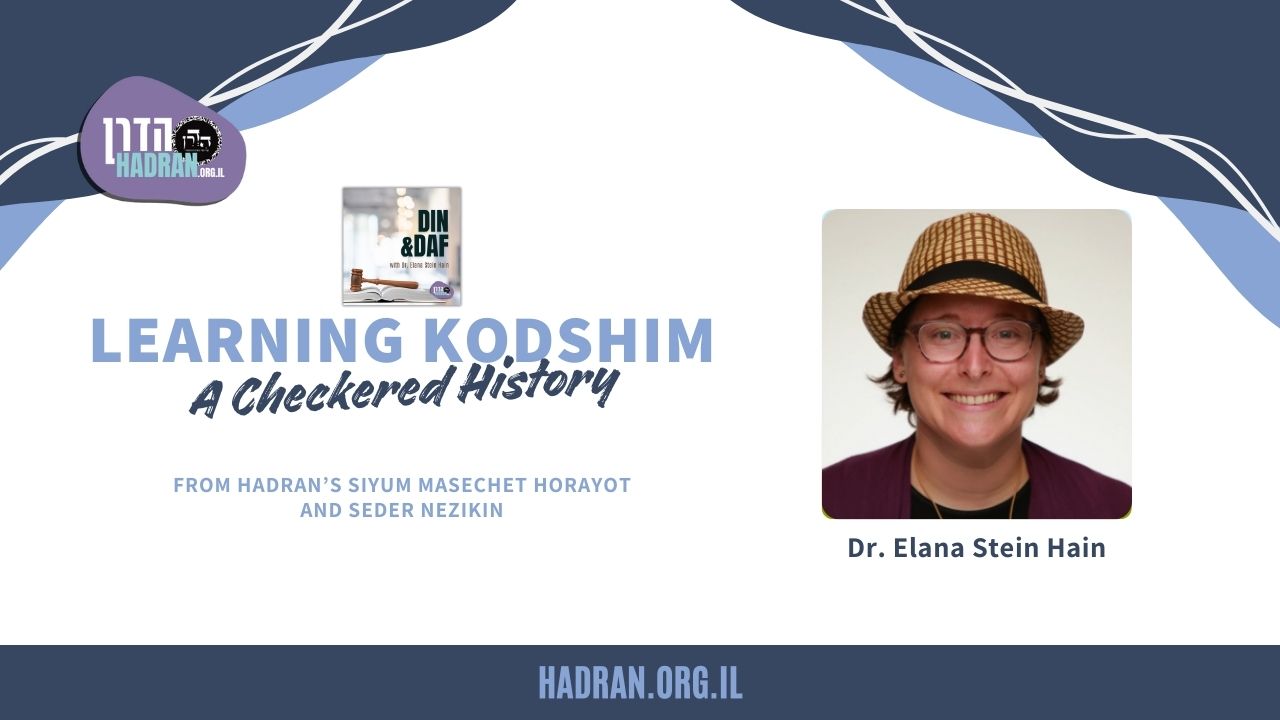הדף היום מוקדש ע”י אמה רינברג לע”נ אמה האהובה מרג’ורי גליק, מרים חנה בת מנחם מנדל ורחל, ביום השנה הרביעית לפטירתה.
רוצים להקדיש למידה? התחל כאן:
העמקה
רוצה להבין מה באמת קורה מתחת לפני השטח של הסוגיה?
שיעורים, פודקאסטים והרחבות של מיטב המורות שלנו יפתחו לך עוד זוויות וכיווני חשיבה.
חדשה בלימוד הגמרא?
זה הדף הראשון שלך? איזו התרגשות עצומה! יש לנו בדיוק את התכנים והכלים שיעזרו לך לעשות את הצעדים הראשונים ללמידה בקצב וברמה שלך, כך תוכלי להרגיש בנוח גם בתוך הסוגיות המורכבות ומאתגרות.
פסיפס הלומדות שלנו
גלי את קהילת הלומדות שלנו, מגוון נשים, רקעים וסיפורים. כולן חלק מתנועה ומסע מרגש ועוצמתי.
עבודה זרה מ״ב
שֶׁל מֵצִיק אֶחָד בְּרִימּוֹן, שֶׁהֵטִילָה נֵפֶל לְבוֹר, וּבָא כֹּהֵן וְהֵצִיץ לֵידַע אִם זָכָר אִם נְקֵבָה, וּבָא מַעֲשֶׂה לִפְנֵי חֲכָמִים וְטִיהֲרוּהוּ, מִפְּנֵי שֶׁחוּלְדָּה וּבַרְדְּלָס מְצוּיִן שָׁם.
of one violent person [metzik] in the city of Rimon, who cast a non-viable newborn into a pit, and a priest came and looked into the pit to ascertain whether the baby was male or whether it was female, as the length of time of a woman’s ritual impurity after childbirth, even if she gave birth to a non-viable newborn, depends on whether the child was male or female (see Leviticus, chapter 12). And the incident came before the Sages to rule whether or not the priest had contracted ritual impurity while standing over the corpse, and they deemed him ritually pure. The basis for this ruling was due to the fact that as martens and polecats [bardelas] are common there, it is likely that the body was dragged away before the priest arrived at the pit.
וְהָא הָכָא, דְּוַדַּאי הֵטִילָה נֵפֶל, סָפֵק גֵּרְרוּהוּ, סָפֵק לֹא גֵּרְרוּהוּ, וְקָאָתֵי סָפֵק וּמוֹצִיא מִידֵי וַדַּאי!
The Gemara concludes its objection: And here, in this case, where it is certain that the woman cast the non-viable newborn into the pit, and it is uncertain whether an animal dragged it away and it is uncertain whether no animal dragged it away, the Sages nevertheless ruled that an uncertainty comes and overrides a certainty.
לָא תֵּימָא הֵטִילָה נֵפֶל לְבוֹר, אֶלָּא אֵימָא: הֵטִילָה כְּמִין נֵפֶל לְבוֹר.
The Gemara rejects this interpretation of the baraita: Do not say that the woman certainly cast a non-viable newborn into a pit; rather, say that she cast an object similar to a non-viable newborn into a pit. Perhaps it was not the body of an infant; it might have merely been congealed blood, which does not impart impurity. Therefore, it is a conflict between uncertainty and uncertainty; it is unclear whether the item that was cast into the pit could have rendered the priest ritually impure, and even if it could have, it might have already been dragged away.
וְהָא ״לֵידַע אִם זָכָר אִם נְקֵבָה הוּא״ קָתָנֵי!
The Gemara asks: But isn’t it taught in the baraita: To ascertain whether it was male or whether it was female, indicating that the only uncertainty was with regard to its sex, as it was certainly a non-viable newborn?
הָכִי קָאָמַר: לֵידַע אִם רוּחַ הִפִּילָה, אִם נֵפֶל הֵטִילָה, וְאִם תִּמְצֵי לוֹמַר נֵפֶל הֵטִילָה — לֵידַע אִם זָכָר אִם נְקֵבָה.
The Gemara answers that this is what the baraita is saying: The priest attempted to examine two aspects of the miscarried entity. He sought to ascertain whether the woman miscarried, bearing an amorphous mass, or whether she cast a non-viable newborn into the pit; and if you say that she cast a non-viable newborn, he sought to ascertain whether it was male or whether it was female.
וְאִיבָּעֵית אֵימָא: כֵּיוָן שֶׁחוּלְדָּה וּבַרְדְּלָס מְצוּיִן שָׁם — וַדַּאי גֵּרְרוּהוּ.
And if you wish, say that there is a different answer: This case is not a conflict between certainty and uncertainty; rather it is a conflict between certainty and certainty. Since martens and polecats are common there, they certainly dragged the body away. Consequently, the ruling in this case does not contradict the principle that an uncertainty does not override a certainty.
אֵיתִיבֵיהּ: מָצָא תַּבְנִית יָד, תַּבְנִית רֶגֶל — הֲרֵי אֵלּוּ אֲסוּרִין, מִפְּנֵי שֶׁכַּיּוֹצֵא בָּהֶן נֶעֱבָד. אַמַּאי? הָא שְׁבָרִים נִינְהוּ!
§ The Gemara returns to the dispute with regard to an idol that broke. Rabbi Yoḥanan raised an objection to the opinion of Reish Lakish from the mishna: If one found an object in the figure of a hand or in the figure of a foot, these are forbidden, as objects similar to those are worshipped. Rabbi Yoḥanan asks: Why are they forbidden? Aren’t they fragments, which according to Reish Lakish should be permitted?
הָא תַּרְגְּמַהּ שְׁמוּאֵל: בְּעוֹמְדִין עַל בְּסִיסָן.
The Gemara answers: Didn’t Shmuel interpret the mishna as referring to a case where these objects are standing on their pedestals, which shows that they were designed this way initially?
אֵיתִיבֵיהּ: גּוֹי מְבַטֵּל עֲבוֹדָה זָרָה שֶׁלּוֹ וְשֶׁל חֲבֵרוֹ, וְיִשְׂרָאֵל אֵינוֹ מְבַטֵּל עֲבוֹדָה זָרָה שֶׁל גּוֹי. אַמַּאי? תֶּיהְוֵי כַּעֲבוֹדָה זָרָה שֶׁנִּשְׁתַּבְּרָה מֵאֵלֶיהָ!
Rabbi Yoḥanan raised another objection to the opinion of Reish Lakish from a mishna (52b): A gentile can revoke the idolatrous status of his own object of idol worship or that of another gentile, but a Jew cannot revoke the status of a gentile’s object of idol worship. Rabbi Yoḥanan asks: Why can’t a Jew revoke the status of a gentile’s idol according to Reish Lakish? Let it be treated like an object of idol worship that broke on its own, which Reish Lakish deems permitted.
אָמַר אַבָּיֵי: שֶׁפְּחָסָהּ. וְכִי פְּחָסָהּ מַאי הָוֵי? וְהָא תְּנַן: פְּחָסָהּ אַף עַל פִּי שֶׁלֹּא חִסְּרָהּ — בִּטְּלָהּ!
Abaye said: That mishna is referring to a case where the Jew bent the idol out of shape without actually breaking it. The Gemara asks: And if he merely bent the idol out of shape, what of it? But didn’t we learn in a mishna (53a) that if one bent an idol, changing its shape, even if he did not remove any part of it, he thereby revoked its status as an object of idol worship?
הָנֵי מִילֵּי דְּפַחֲסַהּ גּוֹי, אֲבָל פַּחֲסַהּ יִשְׂרָאֵל לָא בַּטְּלַהּ.
The Gemara answers: This statement applies only in a case where a gentile bent the idol, changing its shape; but in a case where a Jew bent it, changing its shape, its status as an object of idol worship is not revoked.
וְרָבָא אָמַר: לְעוֹלָם כִּי פַחֲסַהּ יִשְׂרָאֵל נָמֵי בַּטְּלַהּ, אֶלָּא גְּזֵרָה דִּלְמָא מַגְבַּהּ לַהּ וַהֲדַר מְבַטֵּיל לַהּ, וְהָוֵי עֲבוֹדָה זָרָה בְּיַד יִשְׂרָאֵל, וְכׇל עֲבוֹדָה זָרָה בְּיַד יִשְׂרָאֵל אֵינָהּ בְּטֵלָה לְעוֹלָם.
And Rava said a different answer: Actually, the basic halakha is that in a case where a Jew bent it, changing its shape, its status as an object of idol worship is also revoked. But the Sages issued a decree that such an idol retains its idolatrous status, lest a Jew first lift it up and then attempt to revoke its status. In this case the idol’s status is not revoked, as when a Jew lifts an idol he acquires it, and it becomes an object of idol worship in a Jew’s possession, and any object of idol worship in a Jew’s possession can never have its idolatrous status revoked. Therefore, only when an idol breaks on its own does Reish Lakish maintain that its status is revoked.
אֵיתִיבֵיהּ: גּוֹי שֶׁהֵבִיא אֲבָנִים מִן הַמַּרְקוּלִיס, וְחִיפָּה בָּהֶן דְּרָכִים וּטְרַטְיָאוֹת — מוּתָּרוֹת, וְיִשְׂרָאֵל שֶׁהֵבִיא אֲבָנִים מִן הַמַּרְקוּלִיס וְחִיפָּה בָּהֶן דְּרָכִים וּטְרַטְיָאוֹת — אֲסוּרוֹת. אַמַּאי? תֶּיהְוֵי כַּעֲבוֹדָה זָרָה שֶׁנִּשְׁתַּבְּרָה מֵאֵלֶיהָ!
Rabbi Yoḥanan raised another objection to the opinion of Reish Lakish from a baraita: In the case of a gentile who brought stones from stone heaps that were used in the worship of the deity Mercury [HaMarkulis], and who then paved roads and built theaters [vetarteiot] with them, it is permitted to derive benefit from them, as the gentile revoked their idolatrous status. But in the case of a Jew who brought stones that were used in the worship of Mercury and who then paved roads and built theaters with them, it is prohibited to derive benefit from them. Rabbi Yoḥanan asked: According to Reish Lakish, why does a stone such as this retain its idolatrous status? Let it be treated like an object of idol worship that broke on its own, which Reish Lakish deems permitted.
הָכָא נָמֵי, כִּדְרָבָא.
The Gemara answers: Here too, Rabbi Yoḥanan’s question may be answered in accordance with the opinion of Rava that the Sages issued a decree that an object of idol worship retains its idolatrous status when a Jew attempts to revoke it, lest the Jew lift and acquire the idol, which would make it impossible to subsequently revoke its status.
אֵיתִיבֵיהּ: גּוֹי שֶׁשִּׁיפָּה עֲבוֹדָה זָרָה לְצׇרְכּוֹ — הִיא וְשִׁיפּוּיֶיהָ מוּתָּרִין, לְצׇרְכָּהּ — הִיא אֲסוּרָה וְשִׁיפּוּיֶיהָ מוּתָּרִין, וְיִשְׂרָאֵל שֶׁשִּׁיפָּה עֲבוֹדָה זָרָה, בֵּין לְצׇרְכּוֹ בֵּין לְצׇרְכָּהּ — הִיא וְשִׁיפּוּיֶיהָ אֲסוּרִין. אַמַּאי? תֶּיהְוֵי כַּעֲבוֹדָה זָרָה שֶׁנִּשְׁתַּבְּרָה מֵאֵלֶיהָ!
Rabbi Yoḥanan raised another objection to the opinion of Reish Lakish from a baraita: In the case of a gentile who shaved down an object of idol worship for his own sake, as he needed the shavings, the idol itself and its shavings are then permitted. If he did it for the sake of the idol, to improve its appearance, the idol is forbidden, but its shavings are permitted. But in the case of a Jew who shaved down an object of idol worship, whether he did it for his own sake or for the sake of the idol, the idol itself and its shavings are forbidden. Rabbi Yoḥanan asked: According to Reish Lakish, in a case where a Jew shaved the idol for his own sake, why are the shavings forbidden? Let it be treated like an object of idol worship that broke on its own.
הָכָא נָמֵי, כִּדְרָבָא.
The Gemara answers: Here too, Rabbi Yoḥanan’s question may be answered in accordance with the opinion of Rava that the Sages issued a decree that an object of idol worship retains its idolatrous status when a Jew attempts to cause it to be revoked.
אֵיתִיבֵיהּ: רַבִּי יוֹסֵי אוֹמֵר: שׁוֹחֵק וְזוֹרֶה לָרוּחַ אוֹ מֵטִיל לַיָּם. אָמְרוּ לוֹ: אַף הִיא נַעֲשֵׂית זֶבֶל, וּכְתִיב: ״לֹא יִדְבַּק בְּיָדְךָ מְאוּמָה מִן הַחֵרֶם״. אַמַּאי? תֶּיהְוֵי כַּעֲבוֹדָה זָרָה שֶׁנִּשְׁתַּבְּרָה מֵאֵלֶיהָ!
Rabbi Yoḥanan raised another objection to the opinion of Reish Lakish from a mishna (43a): Rabbi Yosei says: When one encounters an idol, he should grind the idol and throw the dust to the wind or cast it into the sea. The Rabbis said to him: What is the good of that? That also gives a Jew benefit from the idol, as it becomes fertilizer for his crops, and deriving any kind of benefit is prohibited, as it is written: “And nothing of the proscribed items shall cleave to your hand” (Deuteronomy 13:18). Rabbi Yoḥanan asked: According to Reish Lakish, why is this prohibited? Let it be treated like an object of idol worship that broke on its own.
הָכָא נָמֵי, כִּדְרָבָא.
The Gemara answers: Here too, Rabbi Yoḥanan’s question may be answered in accordance with the opinion of Rava cited above, that the Sages issued a decree with regard to this matter.
אֵיתִיבֵיהּ: רַבִּי יוֹסֵי בֶּן יָסְיָאן אוֹמֵר: מָצָא צוּרַת דְּרָקוֹן וְרֹאשׁוֹ חָתוּךְ, סָפֵק גּוֹי חֲתָכוֹ סָפֵק יִשְׂרָאֵל חֲתָכוֹ — מוּתָּר, וַדַּאי יִשְׂרָאֵל חֲתָכוֹ — אָסוּר. אַמַּאי? תֶּיהְוֵי כַּעֲבוֹדָה זָרָה שֶׁנִּשְׁתַּבְּרָה מֵאֵלֶיהָ!
Rabbi Yoḥanan raised another objection to the opinion of Reish Lakish from a baraita: Rabbi Yosei ben Yasian says: If one found an object in the figure of a dragon [derakon] with its head severed, but it is uncertain whether a gentile severed it and it is uncertain whether a Jew severed it, the object is permitted. But if it is certain that a Jew severed it, it is forbidden. Rabbi Yoḥanan asked: According to Reish Lakish, why is it forbidden? Let it be treated like an object of idol worship that broke on its own.
הָכָא נָמֵי, כִּדְרָבָא.
The Gemara answers: Here too, Rabbi Yoḥanan’s question may be answered in accordance with the opinion of Rava that the Sages issued a decree with regard to this matter.
אֵיתִיבֵיהּ: רַבִּי יוֹסֵי אוֹמֵר, אַף לֹא יְרָקוֹת בִּימוֹת הַגְּשָׁמִים, מִפְּנֵי שֶׁהַנְּבִיָּיה נוֹשֶׁרֶת עֲלֵיהֶן. אַמַּאי? תֶּיהְוֵי כַּעֲבוֹדָה זָרָה שֶׁנִּשְׁתַּבְּרָה מֵאֵלֶיהָ!
Rabbi Yoḥanan raised another objection to the opinion of Reish Lakish from a baraita: Rabbi Yosei says that one may not even plant vegetables in the rainy season under a tree worshipped as an idol, as foliage may fall on them, serving as fertilizer. Rabbi Yoḥanan asked: According to Reish Lakish, why should a leaf from such a tree retain its idolatrous status? Let it be treated like an object of idol worship that broke on its own.
שָׁאנֵי הָתָם, דְּעִיקַּר עֲבוֹדָה זָרָה קַיֶּימֶת.
The Gemara answers: There it is different, as the main object of idol worship, the tree, still exists fully intact.
וְהָא שִׁיפּוּיָין, דְּעִיקַּר עֲבוֹדָה זָרָה קַיֶּימֶת, וְקָתָנֵי: לְצׇרְכָּהּ — הִיא אֲסוּרָה, וְשִׁיפּוּיֶיהָ מוּתָּרִין!
The Gemara asks: But consider the case of shavings, where the main object of idol worship still exists, and nevertheless it is taught in the baraita cited earlier that if a gentile shaved an idol down for its own sake, the idol is forbidden, but its shavings are permitted. Here too, in the case of the fallen leaves of a tree that is worshipped as an idol, it should be permitted to derive benefit from them.
רַב הוּנָא בְּרֵיהּ דְּרַב יְהוֹשֻׁעַ אָמַר: לְפִי שֶׁאֵין עֲבוֹדָה זָרָה בְּטֵלָה דֶּרֶךְ גְּדִילָתָהּ.
Rav Huna, son of Rav Yehoshua, says: The reason the leaves are not permitted is because the status of an object of idol worship cannot be revoked by its natural manner of growth. Since the falling of leaves is a natural phenomenon, their detachment from the tree does not effect a revocation of their status as objects of idol worship.
אֵיתִיבֵיהּ רַבִּי שִׁמְעוֹן בֶּן לָקִישׁ לְרַבִּי יוֹחָנָן: קֵן שֶׁבְּרֹאשׁ הָאִילָן שֶׁל הֶקְדֵּשׁ — לֹא נֶהֱנִין וְלֹא מוֹעֲלִין, בְּרֹאשָׁהּ שֶׁל אֲשֵׁרָה — יַתִּיז בְּקָנֶה.
Rabbi Shimon ben Lakish raised an objection to the opinion of Rabbi Yoḥanan from a mishna (Me’ila 13b): With regard to a bird’s nest at the top of a tree that belongs to the Temple treasury, one may not derive benefit from it ab initio, but if one derived benefit from it, he is not liable for misuse of property consecrated to the Temple. With regard to a nest that is at the top of a tree used as part of idolatrous rites [ashera], although one may not climb the tree, as that would be benefiting from an object of idol worship, he may knock the nest off with a pole and benefit from it by using it for firewood and the like.
קָא סָלְקָא דַּעְתָּךְ, כְּגוֹן שֶׁשִּׁבְּרָה מִמֶּנּוּ עֵצִים וְקִינְּתָהּ בָּהֶן, וְקָתָנֵי: יַתִּיז בְּקָנֶה.
In analyzing this baraita, it enters your mind that this is referring to a case where the bird broke off branches from the worshipped tree and built a nest with them. And yet, the baraita teaches that one may knock the nest off with a pole and it is then permitted to benefit from it. Apparently, the forbidden branches used in the construction of the nest lost their idolatrous status without human involvement, in accordance with the opinion of Reish Lakish that an idol that breaks loses its status.
הָכָא בְּמַאי עָסְקִינַן? כְּגוֹן דְּאַיְיתַי עֵצִים מֵעָלְמָא, וְקִינְּתָהּ בָּהֶן.
The Gemara explains: Here we are dealing with a case where the bird brought branches from elsewhere and built a nest with them on top of the worshipped tree. The branches were never part of an object of idol worship.
דַּיְקָא נָמֵי, דְּקָתָנֵי גַּבֵּי הֶקְדֵּשׁ: לֹא נֶהֱנִין וְלֹא מוֹעֲלִין; אִי אָמְרַתְּ בִּשְׁלָמָא דְּאַיְיתַי עֵצִים מֵעָלְמָא, הַיְינוּ דְּקָתָנֵי גַּבֵּי הֶקְדֵּשׁ: לֹא נֶהֱנִין וְלֹא מוֹעֲלִין — לֹא נֶהֱנִין מִדְּרַבָּנַן, וְלֹא מוֹעֲלִין מִדְּאוֹרָיְיתָא, דְּהָא לָא קַדִּישִׁי.
The Gemara comments: The language of the mishna is also precise if read with this understanding, as it teaches with regard to a nest in a consecrated tree: One may not derive benefit from it ab initio, but if one derived benefit from it, he is not liable for misuse of consecrated property. Granted, if you say that the bird brought branches from elsewhere, this explanation is consistent with that which the mishna teaches with regard to a nest in a consecrated tree, namely, that one may not derive benefit from it, but if one derived benefit from it, he is not liable for misuse of consecrated property. According to this understanding of the mishna, one may not derive benefit from the nest by rabbinic law, but if one derived benefit from it, he is not liable for misusing consecrated property by Torah law, as the branches are not consecrated, but were brought from elsewhere.
אֶלָּא אִי אָמְרַתְּ שֶׁשִּׁבְּרָה עֵצִים מִמֶּנּוּ, וְקִינְּתָהּ בָּהֶן, אַמַּאי לֹא מוֹעֲלִין? הָא קַדִּישִׁי!
But if you say that the bird broke off branches from the tree itself and built a nest with them, why is it taught that one who derives benefit from it is not liable for misusing consecrated property? Aren’t the branches consecrated? Evidently, the mishna is referring to a nest that was built with branches from other trees, in accordance with Rabbi Yoḥanan’s understanding that an object of idol worship that broke on its own is still forbidden.
מִידֵּי אִירְיָא? הָכָא בְּגִידּוּלִין הַבָּאִין לְאַחַר מִכָּאן עָסְקִינַן, וְקָא סָבַר אֵין מְעִילָה בְּגִידּוּלִין.
The Gemara responds to this proof for Rabbi Yoḥanan’s understanding of the mishna: Does this argument prove anything? The mishna can still be interpreted as referring to a case where the branches for the nest came from the tree itself, and here we are dealing with a case of growths that came afterward, i.e., branches that grew after the tree was consecrated, and the tanna of the mishna holds that there is no prohibition against the misuse of consecrated property with regard to such growths.
וְרַבִּי אֲבָהוּ אָמַר רַבִּי יוֹחָנָן: מַאי ״יַתִּיז״? יַתִּיז בָּאֶפְרוֹחִין.
Another explanation of the mishna in accordance with the opinion of Rabbi Yoḥanan is presented. Rabbi Abbahu says that Rabbi Yoḥanan says: What does it mean that one may knock off the nest? It means that one may knock off the chicks; but one may not derive benefit from the nest itself.
אֲמַר לֵיהּ רַבִּי יַעֲקֹב לְרַבִּי יִרְמְיָה בַּר תַּחְלִיפָא: אַסְבְּרַהּ לָךְ, בְּאֶפְרוֹחִין — כָּאן וְכָאן מוּתָּרִין, בְּבֵיצִים — כָּאן וְכָאן אֲסוּרִין. אָמַר רַב אָשֵׁי: וְאֶפְרוֹחִין שֶׁצְּרִיכִין לְאִמָּן כְּבֵיצִים דָּמוּ.
Rabbi Ya’akov said to Rabbi Yirmeya bar Taḥlifa: I will explain the mishna to you: With regard to the chicks, which can fly away and are not confined to the tree, both here and there, i.e., both in the case of a tree consecrated to the Temple treasury and in the case of a tree used for idol worship, deriving benefit from them is permitted. But with regard to the eggs, both here and there, i.e., both in the case of a tree consecrated to the Temple treasury and in the case of a tree used for idol worship, deriving benefit from them is prohibited, as they are not seen as independent of the tree. Rav Ashi added to this and said: And chicks that still need their mother to survive are considered like eggs; deriving benefit from them is prohibited.
מַתְנִי׳ הַמּוֹצֵא כֵּלִים וַעֲלֵיהֶם צוּרַת חַמָּה, צוּרַת לְבָנָה, צוּרַת דְּרָקוֹן — יוֹלִיכֵם לְיָם הַמֶּלַח. רַבָּן שִׁמְעוֹן בֶּן גַּמְלִיאֵל אוֹמֵר: שֶׁעַל הַמְכוּבָּדִין — אֲסוּרִין, שֶׁעַל הַמְבוּזִּין — מוּתָּרִין.
MISHNA: In the case of one who finds vessels, and upon them is a figure of the sun, a figure of the moon, or a figure of a dragon, he must take them and cast them into the Dead Sea and not derive any benefit from them, as they are assumed to be objects of idol worship. Rabban Shimon ben Gamliel says: Those figures that are upon respectable vessels are forbidden. Those that are upon disgraceful vessels are permitted.
גְּמָ׳ לְמֵימְרָא דִּלְהָנֵי הוּא דְּפָלְחִי לְהוּ, לְמִידֵּי אַחֲרִינָא לָא? וּרְמִינְהִי: הַשּׁוֹחֵט לְשׁוּם יַמִּים, לְשׁוּם נְהָרוֹת, לְשׁוּם מִדְבָּר, לְשׁוּם חַמָּה, לְשׁוּם לְבָנָה, לְשׁוּם כּוֹכָבִים וּמַזָּלוֹת, לְשׁוּם מִיכָאֵל שַׂר הַגָּדוֹל, לְשׁוּם שִׁילְשׁוּל קָטָן — הֲרֵי אֵלּוּ זִבְחֵי מֵתִים!
GEMARA: The Gemara asks with regard to the specific figures listed in the mishna: Is this to say that people worship only these figures, but not any other item? And the Gemara raises a contradiction between this list and that which is taught in another mishna (Ḥullin 39b): With regard to one who slaughters an animal for the sake of, i.e., to worship, seas, for the sake of rivers, for the sake of the wilderness, for the sake of the sun, for the sake of the moon, for the sake of the stars and constellations, for the sake of Michael the great ministering angel, or even for the sake of a small worm, in all of these cases, the animal is forbidden, as these animals have the status of offerings to the dead, i.e., idols.
אָמַר אַבָּיֵי: מִיפְלָח לְכֹל דְּמַשְׁכְּחִי פָּלְחִי, מֵיצָר וּמִפְלָחי — הָנֵי תְּלָתָא דַּחֲשִׁיבִי צָיְירִי לְהוּ וּפָלְחִי לְהוּ, לְמִידֵּי אַחֲרִינָא — לְנוֹי בְּעָלְמָא עָבְדִי לְהוּ.
Abaye said in response to the contradiction: With regard to worship, people might worship any item that they find. With regard to fashioning figures and then worshipping them, only with regard to these three items listed in the mishna, which are important, do people fashion figures of them and worship them. With regard to figures of any other entity, people make them merely for ornamental purposes.
מְנַקֵּיט רַב שֵׁשֶׁת חוּמְרֵי מַתְנְיָיתָא וְתָנֵי: כׇּל הַמַּזָּלוֹת מוּתָּרִין — חוּץ מִמַּזַּל חַמָּה וּלְבָנָה, וְכׇל הַפַּרְצוּפִין מוּתָּרִין — חוּץ מִפַּרְצוּף אָדָם, וְכׇל הַצּוּרוֹת מוּתָּרוֹת — חוּץ מִצּוּרַת דְּרָקוֹן.
Rav Sheshet would consolidate the principles of the baraitot pertaining to this matter and teach: Figures of all constellations are permitted, except for the following celestial objects: The sun and the moon. And figures of all faces are permitted, except for the human face. And all figures of other items are permitted except for the figure of a dragon.
אָמַר מָר: כׇּל הַמַּזָּלוֹת מוּתָּרִין, חוּץ מִמַּזַּל חַמָּה וּלְבָנָה. הָכָא בְּמַאי עָסְקִינַן? אִילֵימָא בְּעוֹשֶׂה — אִי בְּעוֹשֶׂה, כׇּל הַמַּזָּלוֹת מִי שְׁרֵי? וְהָכְתִיב: ״לֹא תַעֲשׂוּן אִתִּי״ — לֹא תַּעֲשׂוּן כִּדְמוּת שַׁמָּשַׁי הַמְשַׁמְּשִׁין לְפָנַי בַּמָּרוֹם.
The Master said: Figures of all constellations are permitted, except for the following celestial objects: The sun and the moon. The Gemara asks: What are we dealing with here? If we say that the reference is to one who forms these figures, i.e., if Rav Sheshet is discussing the issue of which figures it is permitted to form, is forming figures of all the other constellations permitted? But isn’t it written: “You shall not make with Me gods of silver, or gods of gold, you shall not make for you” (Exodus 20:20)? This verse is interpreted to mean: You shall not make figures of My attendants who serve before Me on high, i.e., those celestial bodies, including the constellations, that were created to serve God.
אֶלָּא פְּשִׁיטָא בְּמוֹצֵא, וּכְדִתְנַן: הַמּוֹצֵא כֵּלִים וַעֲלֵיהֶם צוּרַת חַמָּה, צוּרַת לְבָנָה, צוּרַת דְּרָקוֹן — יוֹלִיכֵם לְיָם הַמֶּלַח.
Rather, it is obvious that this halakha is referring to a case where one finds vessels with these figures on them, and this is as we learned in the mishna: In the case of one who finds vessels, and upon them is a figure of the sun, a figure of the moon, or a figure of a dragon, he must take them and cast them into the Dead Sea. This indicates that it is permitted to derive benefit from any other vessels that were found and that had figures on them.
אִי בְּמוֹצֵא, אֵימָא מְצִיעֲתָא: כׇּל הַפַּרְצוּפוֹת מוּתָּרִין חוּץ מִפַּרְצוּף אָדָם; אִי בְּמוֹצֵא, פַּרְצוּף אָדָם מִי אָסוּר? וְהָתְנַן: הַמּוֹצֵא כֵּלִים וַעֲלֵיהֶם צוּרַת חַמָּה, צוּרַת לְבָנָה, צוּרַת דְּרָקוֹן — יוֹלִיכֵם לְיָם הַמֶּלַח. צוּרַת דְּרָקוֹן — אִין, פַּרְצוּף אָדָם — לָא!
The Gemara asks: If it is a case where one finds vessels with these figures on them, say the middle clause of Rav Sheshet’s statement: Figures of all faces are permitted, except for the human face. Now, if it is a case where one finds vessels with figures on them, is a vessel with the figure of the human face forbidden? But didn’t we learn in the mishna: In the case of one who finds vessels, and upon them is a figure of the sun, a figure of the moon, or a figure of a dragon, he must take them and cast them into the Dead Sea? This indicates that a vessel with the figure of a dragon is forbidden, but a vessel with the figure of a human face is not.
אֶלָּא פְּשִׁיטָא בְּעוֹשֶׂה, וְכִדְרַב הוּנָא בְּרֵיהּ דְּרַב יְהוֹשֻׁעַ.
Rather, the Gemara concludes, it is obvious that the statement that the figure of a human face is forbidden is referring to a case where one forms a figure, and this is prohibited, in accordance with the statement of Rav Huna, son of Rav Yehoshua, who states (43b) that the interpretation of the verse: “You shall not make with Me gods of silver, or gods of gold, you shall not make for you” (Exodus 20:20), is: Do not make of Me, i.e., do not form the figure of a person, who was created in the image of God.
אִי בְּעוֹשֶׂה, אֵימָא סֵיפָא: כׇּל הַצּוּרוֹת מוּתָּרוֹת — חוּץ מִצּוּרַת דְּרָקוֹן; וְאִי בְּעוֹשֶׂה, צוּרַת דְּרָקוֹן מִי אֲסִיר? וְהָכְתִיב: ״לֹא תַעֲשׂוּן אִתִּי אֱלֹהֵי כֶסֶף וֵאלֹהֵי זָהָב״,
The Gemara asks: If it is referring to a case where one forms a figure, say the last clause of Rav Sheshet’s statement: All figures are permitted except for the figure of a dragon. And if it is referring to a case where one forms a figure, is forming the figure of a dragon prohibited? But isn’t it written: “You shall not make with Me gods of silver, or gods of gold”?
